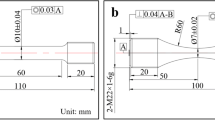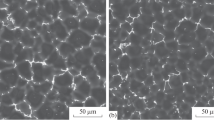Conclusions
-
1.
Small additions of zirconium (and particularly chromium) substantially increase the variation of the strength with the time interval between quenching and artificial aging of Al−4.5 Zr−2.0 Mg−0.35 Mn, which is due to the increased surface of subgrain boundaries and the interface between the matrix and the intermetallic compound of aluminum and the transition metal.
-
2.
Small additions of copper reduce the variation of the strength with the time interval between quenching and artificial aging.
Similar content being viewed by others
Literature cited
N. Nid, Aluminum Suise,13, No. 2 (1963).
I. N. Fridlyander, Metal. i Term. Obrabotka Metal., No. 8 (1965).
V. I. Elagin, Metal. i Term. Obrabotka Metal., No. 8 (1966).
R. R. Romanova et al., Fiz. Metal. Metalloved., 23 (1967).
V. V. Zakharov et al., Fiz. Metal. Metalloved.,27, (1969).
Y. Baba, Japan Institute of Metals,31, No. 4 (1967).
Additional information
All-Union Institute of Light Alloys. Translated from Metallovedenie i Termicheskaya Obrabotka Metallov, No. 5, pp. 61–62, May, 1971.
Rights and permissions
About this article
Cite this article
Zakharov, V.V., Levin, L.I. & Romanova, G.M. The effect of “rest” on artificial aging of Al−Zn−Mg−Mn alloys. Met Sci Heat Treat 13, 418–419 (1971). https://doi.org/10.1007/BF00652455
Issue Date:
DOI: https://doi.org/10.1007/BF00652455




